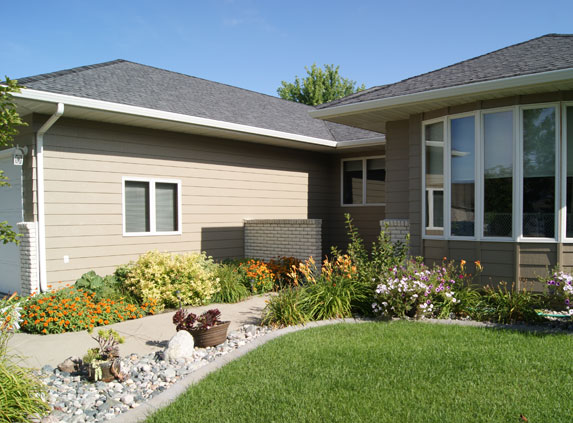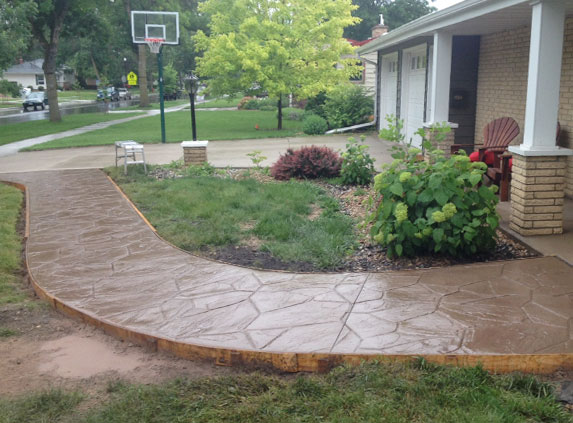
Hydro-Mulch
Our customers often ask what the benefits are of using the seed versus sod method when installing a new yard. Many will argue that seeding allows for a deeper and better-rooted lawn culture. Others will say that hydro-mulch comes in a weedy mess and they’d only consider sod as a solution. Here’s a little Q and A with our input to weigh into both comments.
Q: What is included with a hydro-mulch application?
A: Our hydro-mulch is comprised of multiple products, including: premium Kentucky bluegrass seed, granular fertilizer to boost germination, a tackifier/fiber blend to secure the seed and water to create a slurry mix of all the ingredients.
Q: Does seeding take longer to come in than sod?
A: The answer to this question is an obvious “yes”, however; the time difference between the two different applications may actually surprise you. Hydro-mulch has the opportunity to create a beautiful lawn, but it can take between 5 and 6 weeks to fully mature and become lush. In theory, sod is that “immediate green” satisfaction, but traditionally you want to wait at least 2 or 3 weeks before putting regular foot traffic on it to allow the roots time to establish. So when our customers are struggling to make the decision between “seed” or “sod”, we most often recommend hydro-mulch. This allows the home or business owner to get the same end product with about half the cost and only a 2 to 3 week extension on use timeline.
Q: Does sod have any disadvantages?
A: Yes. Although sod can seem like an immediate plus, “quick fixes” almost always have a down side that is worth discussing. When sod is cut from harvest fields, the root layer is about 1 1/2″ to 2″ thick. The sod is stored in rolls for a short amount of time before installation (this time allows for shipping to the region, additional transit to the work site and a contractor’s job schedule). When the sod is installed, it requires a tremendous amount of water to kickstart the root growth again. In the industry, we have seen some issues with root growth penetrating the clay-based soil in the Fargo-Moorhead region. There has been a trend of snow-mold forming and destroying yards that were originally sodded about 5-7 years after installation.
Q: How much does sod cost in comparison to seed?
A: When compared to a hydro-mulch application like ours, we generally see the cost of sod equalling to about double the expense in a standard residential yard. This can be an alternate upgrade of several thousand dollars.
Q: What is the best time to hydro-mulch?
A: The answer to this question comes in two parts. (a) If irrigation is installed prior to the hydro-mulch, we are able to get good results from mid May through early November. (b) If hydro-mulch is being installed on its own, with no irrigation system, we prefer early summer or late fall applications for optimum results.
Q: How late in the season is “too late” to seed or sod?
A: This changes every year. Traditionally, early November in North Dakota and Northern Minnesota is the latest that we have installed either of the products. Sod goes dormant when the weather starts turning colder and Kentucky bluegrass seed does the same thing. So late fall applications of seed are generally expected to come in the following spring.
Q: How do I avoid weeds overtaking my new lawn?
A: When you install new hydro-mulch (or sod), weeds can be a major problem. Our best recommendation for eliminating the unwelcome vegetation is to (a) install a fresh layer of finely-screened top soil, (b) install an irrigation system, (c) install your lawn during the early summer or late fall and (d) invest in a weed control and fertilizer program. When you invest in additional top soil over your builder’s rough grade, you get a smoother fine grade and the hydro-mulch has a better opportunity to grow…not having to compete with existing weed seed in the often-compromised rough grade soils. Irrigation systems help control the water amounts and give your sod or seed the constant maintenance that it needs to grow well. Sod or hydro-mulch installation during the peak of the hot summer or during the driest months, can promote rapid weed growth (since they thrive in those conditions) and make it hard for the grass to come in thick as it should. Finally, a fertilizer and weed control program can help you get a handle on your lawn early (before the weeds take root and spread). We recommend that newly sodded lawns be given at least a month before the weed control chemicals be used, but fertilizer can be applied right away. Hydro-mulched or seeded lawns take longer to grow in and should be given more time to root before applying the weed control. Fertilizer should be used used with caution so the lawn isn’t “burned” when it is brand new. If you have questions or want to sign up for a custom regimen, feel free to contact our office.
. . .
Our staff has developed a nifty Project Planning Guide for your reference if you want to start doing a little research of your own before you hire a professional contractor to get the job done for you. We welcome any thoughts, comments or questions from our fans! Let us know if you have any other tips and tricks you’d recommend for someone looking for services.



We Build Long Lasting Relationships
David C
